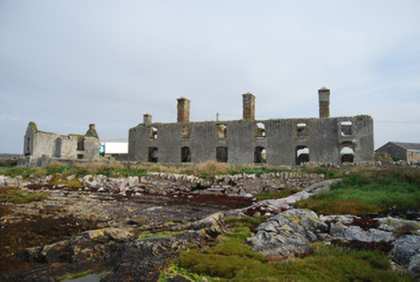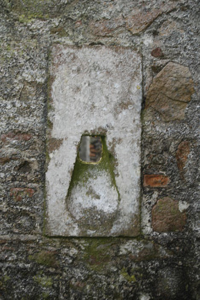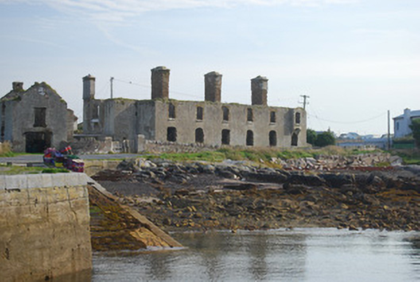Survey Data
Reg No
30409013
Rating
Regional
Categories of Special Interest
Architectural, Social
Original Use
Coastguard station
Date
1870 - 1880
Coordinates
96654, 222845
Date Recorded
25/09/2008
Date Updated
--/--/--
Description
Detached six-bay two-storey former coastguard station, built c.1875, now ruinous, with three lean-to sections along rear (north-east elevation), concrete water tanks to east elevation, single-storey lean-to outhouses (animal sheds) to rear, single-storey store to north and two-storey store (formerly house associated with original station c.1830) with cart entrance to north-west. Pitched (but possibly hipped) slate roof with smooth rendered brick chimneystacks. Smooth rendered walls and plinth over rubble stone, iron vents below ground floor window openings and concrete moulded gun loops to each end of lean-to porch. Square and camber-headed openings to windows with concrete sills, yellow brick surrounds and brick arches. Two bartizan-type additions to first floor openings situated on east end of south-west elevation and north-west gable end, comprising rendered concrete with camber-headed openings having gun loops to side elevations and iron hinges to interior. Building located to east of quay on shoreline and contained within rubble stone enclosure with rendered piers to entrance. Single and two-storey outbuildings of rubble stone construction with pitched roofs, having brick surrounds to openings, single-storey outbuilding having pitched artificial slate roof and two-storey one having brick chimneystack.
Appraisal
This large imposing building was a replacement for a previous Coastguard Station that was sited just to the north-west of the present structure. Only the two-storey storehouse remains from this station and was incorporated into the new one. The existing station was later used as a barracks by the Black and Tans and was burnt down during the War of Independence. The building is notable for its position overlooking Cuan Cashla [Cashla or Costelloe Bay] and its later fortifications, such as the projecting bartizan-type defensive window surrounds and variously positioned gun loops. This structure is an important part of the region's maritime and military heritage.







